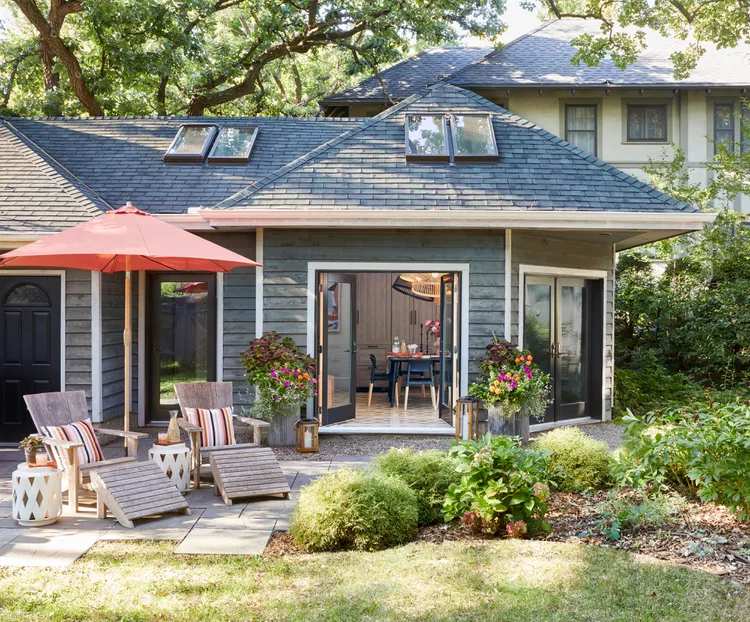Achieving low-maintenance landscaping is all about applying the adage “work smarter, not harder” to your lawn and garden. Landscape chores, including trimming, weeding, and watering, can consume hours, but they don’t have to. These time-saving practices and techniques can reduce your chore list and free up time for you to finally sit in the seating area you designed for your patio. Many of the 11 tips included here take only a few minutes to do, but when they are done well, they prevent hours of work later in the season.
1. Layer on Some Mulch
Stop weeds before they germinate with a 2-inch-thick layer of mulch. Shredded bark, pine straw, grass clippings, and cocoa hulls are all excellent mulch products. In time, these organic products decompose, adding valuable nutrients to the soil. However, it's possible to have too much of a good thing. More than 2 inches of mulch has the potential to compromise plant growth, so don't be tempted to go overboard (plus that would be extra work, and that's not the goal at all).
2. Embrace Simple Lines
Mowing and trimming is easiest and fastest along straight lines and gentle curves. When designing a garden bed or foundation planting, opt for a simple outline rather than a complicated shape. When possible, unite separate plants or small beds into one large planting area for a continuous mowing pattern. It is much faster to mow around one large planting bed than many single trees and shrubs.
3. Invest in High-Quality Tools
High-quality tools have longer life spans than cheaply made tools, and the best tools function optimally, making garden chores easier and more inviting. Invest in a sturdy spade, shovel, hand pruners, loppers, and hedge trimmers if your landscape includes many shrubs that require pruning to maintain size or shape.
4. Practice Right Plant, Right Place
Low-maintenance landscaping has no room for finicky plants. Know your space—sunlight, soil texture, hardiness zone—and choose plants that thrive in your garden’s specific conditions. Is fast-draining, sandy soil, full sun, and limited rainfall the theme of your landscape? Drought-tolerant plants are your best bet. Do you have a shady backyard? Choose shade-loving shrubs, such as hydrangeas and rhododendrons, and understory trees to create a low-light garden oasis. Don’t fight the existing landscape conditions—garden in tandem with them.
5. Search Out Natives
Time-savvy gardeners love native plants. Natives are usually better able to thrive in the unique growing conditions of your region, and often require less maintenance than non-native plants. Plus, natives benefit your local ecosystem far more than other types of plants. Connect with your local extension service, garden center, or public garden to learn about native plants specific to your area.
6. Limit Plant Types
Simple plantings with only a few species make for easier maintenance. Repeat the species that grow well in your garden throughout your landscape. For example, if hydrangeas grow and flower with ease in your front yard, add them to backyard planting areas, too, if the growing conditions are similar.
7. Catch Pests Early
Identifying garden pests and diseases before they multiply minimizes maintenance needs. Take a weekly walk through your landscape while looking for unusual leaf or stem damage. Take time to sleuth out the cause and take steps to modify the conditions around the affected plant to discourage the pests or stop the disease.
8. Make a Pruning Plan
Often gardeners wait until a shrub or tree is overgrown before wielding their cutting tools. If you prune proactively, you won't end up with a ton of work to tame your wayward plants. Prune flowering shrubs annually after they bloom. Prune non-flowering shrubs and evergreen trees and shrubs in late summer. Prune deciduous trees in late winter before they leaf out in spring.
9. Define the Edge
A defined edge around a landscape bed saves maintenance by keeping mulch inside the bed and turf grass outside. Use brick or pavers to make a long-lasting bed edge. Steel, aluminum, and plastic edging will work too. A spade-cut edge resembling a mini trench is also a great method, although it needs to be recut annually.
10. Water with a Timer
A drip hose and a timer are handy investments—especially in vegetable gardens. For ease and efficiency, put the drip hose in place at planting time. Adjust the timer to deliver water to the plants throughout the season.
11. Cluster Containers
There’s no way around it—container gardens require supplemental water. Water-retentive potting soil and a drip irrigation system can reduce the time needed for this garden chore. If a drip irrigation system isn’t practical for your container gardens, cluster pots together to simplify the watering process. Perhaps your patio is a focal point for container plantings. Instead of watering pots tucked here and there around the perimeter of the house, gather all the pots on the patio where they are easily reachable from a single hose.




















